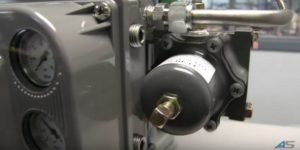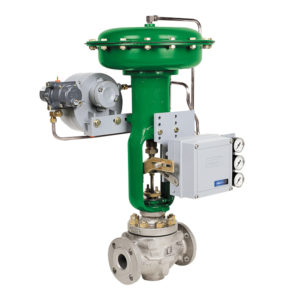By Walt Boyes
In the video, “Importance of Using a Filter Regulator,” Eric Williams, valve assessment specialist at Automation Service, explained that using a filter regulator with pneumatically actuated valves is a great small investment. It can significantly extend the life of pneumatic instrumentation. He notes that the major cause of failure in pneumatic instruments is poor air quality. Click here to watch the video.
Regulator,” Eric Williams, valve assessment specialist at Automation Service, explained that using a filter regulator with pneumatically actuated valves is a great small investment. It can significantly extend the life of pneumatic instrumentation. He notes that the major cause of failure in pneumatic instruments is poor air quality. Click here to watch the video.
What Does a Filter Regulator Do?
A filter and regulator do two very important things. First, the filter removes liquid and debris from the air line. This protects the internal passages in the pneumatic valve positioner, actuator, or pneumatic instrumentation. As Eric noted, the regulator prevents the air line from overpressurization by controlling the pressure prior to the instrument. As he pointed out, actuators will malfunction if they are overpressured.
Routine Control Valve Maintenance Tips
Routine maintenance of the filter and regulator are required because of plugging, but also because it permits the technicians to find a very costly maintenance issue: leaking air lines. Leaking air and nitrogen piping around the plant is an energy sink—electric costs continue to rise, and wasting electricity by running compressors at peak energy use times is becoming significantly expensive.
Checking the filter also gets you a look at the debris. If you are seeing weld-splatter, or lots of corrosion byproducts, you can start tracing upstream for where the welding gunk came from and start looking for corroding air lines.
Routine checking of the dripwell and draining the accumulated water out via the drain valve is also an inexpensive way to avoid expensive repairs. If the filter and regulator are waterlogged, If this happens a lot, it may indicate that there is a leak that is letting water in, not just condensation collecting in the dripwell.
Reduce Actuator Costs
All of these tips help you to keep your valve actuators healthy. They aren’t big things, or terribly time-consuming, but they can do a lot to reduce your maintenance cost for actuators and positioners. If you have dozens of actuators and positioners, you can see significant cost savings by simply finding a few filters and regulators before they can be damaged, and do damage to the actuator.
Be sure to check out Eric’s Two Cent Tech Tip for more information. If you have any questions, please give us a call at 800-325-4808. And don’t forget to check back on our video gallery and social media channels for future Two Cent Tech Tips!

Walt Boyes has more than 40 years of experience in the automation industry, including Executive Committee experience in three companies, and board of directors service in both for-profit and not-for-profit companies. Walt is principal in Spitzer and Boyes LLC, a technology consulting firm assisting companies to better market their products in manufacturing and automation. He has contributed to many industry publications as both writer and editor. View Walt’s full bio.

